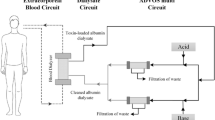Abstract
Background
In children acute liver failure is a rare but life-threatening condition from which two-thirds do not recover with supportive therapy. Treatment is limited by the availability of liver transplants. Molecular adsorbent recirculating system (MARS) dialysis is a bridge to transplantation that enhances the chances of survival during the waiting period for a transplant, although it cannot improve survival. Open albumin dialysis (OPAL) is a new mode of albumin dialysis developed to further improve dialysis efficiency.
Case diagnosis/treatment
We report a paediatric case of acute-on-chronic liver failure and compare the two modes of albumin dialysis, namely, the MARS and OPAL, used to treat this patient’s cholestatic pruritus. Removal of total and direct bilirubin, ammonia and bile acids were measured by serial blood tests. There was an increased removal of bile acids with the OPAL mode, whereas the removal of total and direct bilirubin and ammonia was similar in both modes. The patient reported better improvement in pruritus following OPAL compared to dialysis with the MARS.
Conclusion
OPAL may offer a better solution than the MARS in the treatment of refractory pruritus in liver failure.
Similar content being viewed by others
References
Cochran JB, Losek JD (2007) Acute liver failure in children. Pediatr Emerg Care 23:129–135
Stange J, Ramlow W, Mitzner S, Schmidt R, Klinkmann H (1993) Dialysis against a recycled albumin solution enables the removal of albumin-bound toxins. Artif Organs 17:809–813
Schaefer B, Schaefer F, Engelmann G, Meyburg J, Heckert KH, Zorn M, Schmitt CP (2011) Comparison of Molecular Adsorbents Recirculating System (MARS) dialysis with combined plasma exchange and haemodialysis in children with acute liver failure. Nephrol Dial Transplant 26:3633–3639
Mitzner SR, Stange J, Klammt S, Risler T, Erley CM, Bader BD, Berger ED, Lauchart W, Peszynski P, Freytag J, Hickstein H, Loock J, Lohr JM, Liebe S, Emmrich J, Korten G, Schmidt R (2000) Improvement of hepatorenal syndrome with extracorporeal albumin dialysis MARS: results of a prospective, randomized, controlled clinical trial. Liver Transpl 6:277–286
Catalina MV, Barrio J, Anaya F, Salcedo M, Rincon D, Clemente G, Banares R (2003) Hepatic and systemic haemodynamic changes after MARS in patients with acute on chronic liver failure. Liver Int 23[Suppl 3]:39–43
Heemann U, Treichel U, Loock J, Philipp T, Gerken G, Malago M, Klammt S, Loehr M, Liebe S, Mitzner S, Schmidt R, Stange J (2002) Albumin dialysis in cirrhosis with superimposed acute liver injury: a prospective, controlled study. Hepatology 36:949–958
Hassanein TI, Tofteng F, Brown RS Jr, McGuire B, Lynch P, Mehta R, Larsen FS, Gornbein J, Stange J, Blei AT (2007) Randomized controlled study of extracorporeal albumin dialysis for hepatic encephalopathy in advanced cirrhosis. Hepatology 46:1853–1862
Vaid A, Chweich H, Balk EM, Jaber BL (2012) Molecular adsorbent recirculating system as artificial support therapy for liver failure: a meta-analysis. ASAIO J 58:51–59
Schaefer B, Schaefer F, Wittmer D, Engelmann G, Wenning D, Schmitt CP (2012) Molecular adsorbents recirculating system dialysis in children with cholestatic pruritus. Pediatr Nephrol 27:829–834
Pares A, Cisneros L, Salmeron JM, Caballeria L, Mas A, Torras A, Rodes J (2004) Extracorporeal albumin dialysis: a procedure for prolonged relief of intractable pruritus in patients with primary biliary cirrhosis. Am J Gastroenterol 99:1105–1110
Bellmann R, Graziadei IW, Feistritzer C, Schwaighofer H, Stellaard F, Sturm E, Wiedermann CJ, Joannidis M (2004) Treatment of refractory cholestatic pruritus after liver transplantation with albumin dialysis. Liver Transpl 10:107–114
Schaefer B, Schmitt CP (2013) The role of molecular adsorbent recirculating system dialysis for extracorporeal liver support in children. Pediatr Nephrol 28:1763–1769
Banares R, Nevens F, Larsen FS, Jalan R, Albillos A, Dollinger M, Saliba F, Sauerbruch T, Klammt S, Ockenga J, Pares A, Wendon J, Brunnler T, Kramer L, Mathurin P, de la Mata M, Gasbarrini A, Mullhaupt B, Wilmer A, Laleman W, Eefsen M, Sen S, Zipprich A, Tenorio T, Pavesi M, Schmidt HH, Mitzner S, Williams R, Arroyo V, group Rs (2013) Extracorporeal albumin dialysis with the molecular adsorbent recirculating system in acute-on-chronic liver failure: the RELIEF trial. Hepatology 57:1153–1162
Bachli EB, Schuepbach RA, Maggiorini M, Stocker R, Mullhaupt B, Renner EL (2007) Artificial liver support with the molecular adsorbent recirculating system: activation of coagulation and bleeding complications. Liver Int 27:475–484
Evenepoel P, Laleman W, Wilmer A, Claes K, Kuypers D, Bammens B, Nevens F, Vanrenterghem Y (2006) Prometheus versus molecular adsorbents recirculating system: comparison of efficiency in two different liver detoxification devices. Artif Organs 30:276–284
Contributors’ statements
Euan Soo drafted the initial manuscript, carried out the analyses of data, presented the data and approved the final manuscript as submitted. Anja Sanders significantly contributed to the statistics, data presentation and the manuscript. Karlheinz Heckert was responsible for performing and monitoring liver dialysis episodes and coordinating the investigations for the study and approved the final manuscript as submitted. Tobias Vinke helped with data collecting and analysis and approved the final version of the manuscript. Franz Schaefer conceptualized the study, critically reviewed the manuscript and approved the final manuscript as submitted. Claus Peter Schmitt conceptualized the study, realized the study, critically reviewed the manuscript, contributed to data analysis and approved the final manuscript as submitted.
All authors approved the final manuscript as submitted and agree to be accountable for all aspects of the work.
Author information
Authors and Affiliations
Corresponding author
Ethics declarations
Funding source
ES was supported by a grant from the Hospital Authority of Hong Kong.
Conflict of interest statement
The authors declare that they have no conflicts of interest regarding this work.
Electronic supplementary material
Below is the link to the electronic supplementary material.
ESM 1
(DOCX 55.4 kb)
Rights and permissions
About this article
Cite this article
Soo, E., Sanders, A., Heckert, K. et al. Comparison of two different modes of molecular adsorbent recycling systems for liver dialysis. Pediatr Nephrol 31, 2171–2174 (2016). https://doi.org/10.1007/s00467-016-3451-0
Received:
Revised:
Accepted:
Published:
Issue Date:
DOI: https://doi.org/10.1007/s00467-016-3451-0




